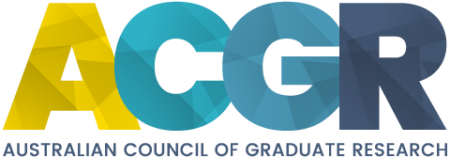Professor Alastair McEwan
Convenor, ACGR and Pro-Vice-Chancellor (Research Training), University of Queensland
Quality supervision is one of the characteristics of an excellent HDR Program. The Australian Council of Learned Academies (ACOLA) Review of Australia’s Research Training System (2016) certainly held this view and this led to significant changes to the expectations associated with HDR Programs in Australia, articulated in the ACOLA Research Training Implementation Plan (ACOLA RTIP). The ACOLA Implementation Plan Summary Section 4. ‘Quality of the HDR Training System’ included a sub-section dedicated to HDR supervision: 4.4 Better address HDR supervision responsibilities in academic performance expectations. ACGR (Australian Council of Graduate Research) has developed guidelines, ACGR Guidelines for Quality Graduate Research Supervision, to support universities to better manage and reward performance at the institutional level that included:
- formal inclusion of monitoring of research supervision performance in performance reviews
- the development of metrics to inform regular performance reviews and other processes such as academic promotion
- reviewing university career structures and academic promotion processes to appropriately recognise industry engagement as well as traditional scholarly outputs.
Putting such changes into effect has its challenges. In an earlier Blog Justin Zoebel looked at the case for consideration of HDR candidates as researchers rather than students. The same ambiguity plays out in appraisals of academic staff. Should supervision be considered within their research performance or is it a component of teaching & learning? Neither of these domains are particularly satisfactory since discussions about supervision and development of HDR candidates are not at the forefront of research performance evaluations or the evaluation of effectiveness in teaching & learning.
At UQ we started thinking about this challenge as part of a review of academic performance and development processes. Initially, the focus was on metrics associated with HDR supervision as a distinct section in each staff members’ Individual Activity Profile (IAP). This profile measures HDR Advisory load, HDR Candidate progression, completion times and withdrawals associated with an individual academic as measured against their peers. Following the establishment of a dedicated section within the IAP attention turned to the creation of a separate domain for Supervision of HDR Candidates within the new academic performance and development framework. For many at the University an ‘HDR’ domain was too narrow and so it was to broadened include Early Career Researchers (ECRs) and coursework students who develop through research activity (UG research trainees, Honours and PG coursework students). This the new domain, ‘Supervision and Researcher Development’, aligns well with the focus of the Universities Australia/NHMRC/ARC guide to Supervision.
Discussing the metrics of HDR supervisory performance is an important component of an academic appraisal but it does not address the ‘development’ component of supervision that is so central to the purpose of research training. What should be evaluated and discussed? The ‘Supervision and Researcher Development’ domain is divided into five domain activities:
Supervision outcomes: this includes timely progression of HDR students through stages of their candidature, timely completion of HDR students with minimal late-stage withdrawal from their program, contribution to ECR and HDR student achievement through publishing and grant success, ECR and HDR student career progression facilitated through structured performance and development discussions.
Responsible conduct of research: this references the core expectation of the UA Guide to Supervision mention earlier and aims to ensure that all supervisees are provided with appropriate training in relation to research integrity & ethics policies as well as promotion of a safe workplace; instilling an understanding of the responsible conduct of research: the importance of rigour, in the development, collection, and reporting of research data and findings; a fair and transparent approach to authorship; promotion of cultural awareness and recognition and the intersection of Indigenous knowledges with research
Capability and skill development: this makes it clear that supervisors should be responsible for the broader development of HDRs and ECRs through the building of specific research skills, technical capabilities, manuscript and grant writing capabilities but also through the development of communication skills that relate to public/end-user engagement and research impact, the development of teaching skills and capabilities and through support of the development of supervisory capabilities of HDRs and ECRs
Engagement: encourages/facilitates supervisee involvement in discipline-based societies/professional associations, participation in industry mentoring programs, and supports placement/internship opportunities, develops supervisee knowledge exchange capabilities through discussions with external stakeholders. Many supervisors support these aspects of researcher development, but they are not always recognised or rewarded.
Leadership: this recognises the importance of enhancing personal effectiveness as a supervisor through development/training and also the contribution to professional development of supervision capabilities across the university, national and international societies, professional associations and peak bodies.
The creation of a ‘Supervision and Researcher Development’ domain at UQ represents an explicit commitment to ‘people’ development through research and it embeds the broader expectations of supervision aimed at developing HDRs and ECRs who can enter a wide variety of careers.
Photo by Jehyun Sung on Unsplash

